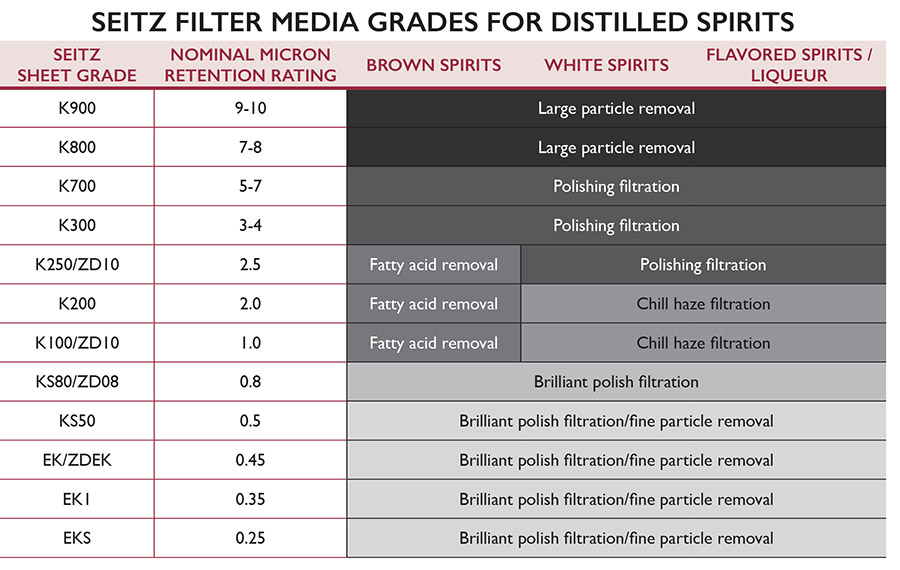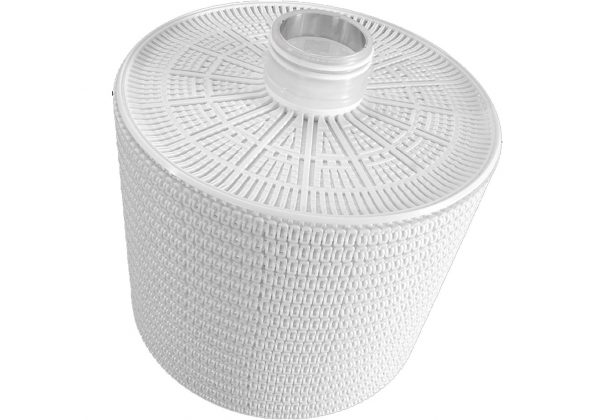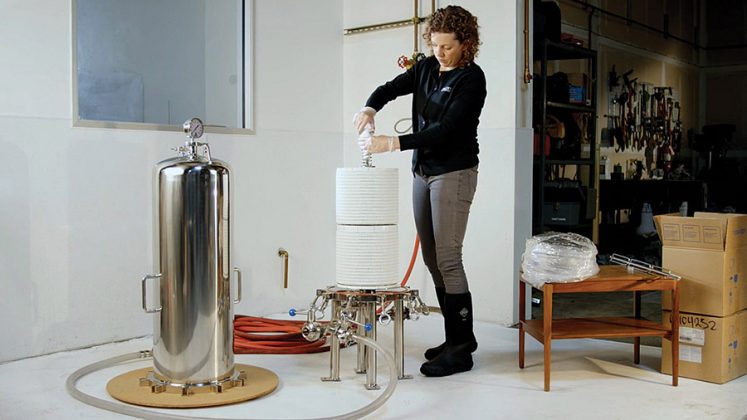The filtration of extra-precious liquids such as distilled spirits can be both challenging and intimidating.
The goal of filtration is to improve the product by removing contaminants which mask the quality components that contribute to flavor, color, mouthfeel, etc. In turn, filtration reveals the true beauty of what lies beneath.
Fortunately, we have many different options for reaching this goal whether you’re wanting to filter five gallons or hundreds upon thousands.
First, it is important to understand what we’re attempting to remove. Let’s look at what contributes to a particular type of haze.
Before we go over different filtration types, let’s look at the mechanics of dirt-holding capacity in classic-depth media. It is a three-way action that is made up of surface filtration, depth filtration and adsorption. Let’s review the different filtration equipment and see how these attributes stack up.
Bag filters
Bag filters are essentially a surface filtration step to catch bigger particles, such as barrel char or fruit and spice particles to lighten the load before a more substantial depth filtration. Bag filters have very low depth capacity and practically no adsorption capability. The nice thing is that this is a closed system and you can either use the mesh basket that comes with most models or add a welded (i.e., not stitched), polypropylene felt bag to help with efficiency. They’re popular in bigger facilities where high flow rates are required when unloading bulk containers on the way to storage tanks, or even on the way to packaging. Bag filters are usually available in porosities as coarse as 200-micron and as tight as one-micron.
Filter cartridges
Cartridge filtration is a very popular method of surface and depth filtration because of the lower price of the media and housings. Depth filter-cartridge media is typically made of polypropylene, usually in the pleated format but also in melt-blown formats. For small-batch filtration it is best to use a 30” code 7 cartridge housing so that you have the option to use 10”, 20” or 30” cartridges in that housing since the code-7 adaptor has two locking tabs to keep a shorter cartridge in place in a taller cartridge housing. Cartridge housings are also available in multi-round sizes like 3-round, 5-round, etc. so that the number of cartridges can fit in the same housing, thereby increasing your surface area and flow rates. Whereas a regular depth cartridge is constructed of many layers of polypropylene sheets layered on top of each other and then pleated, others are spun onto a central core. Their dirt-holding capacity consists of surface and depth filtration attributes, but they usually have very little to offer in terms of adsorption.
Some cartridges are constructed of membrane media that have adsorption capabilities in the form of very low binding, negatively charged glass fiber (GF), or cellulose acetate (CA) media that respect the aromatics of sensitive products. Some distilleries prefer to use membrane media to better control their filtrate consistency and remove colloidal haze on small batches.
The pores in a membrane media are more defined and usually consist of a single membrane layer with other supporting media layers on either side to strengthen and support that membrane layer. Membranes do not have much depth capacity compared to other depth filters, but they are high-precision filters because their pores stay rigid and can handle many pressure spikes throughout the lifespan of the media without being compromised, unlike some polypropylene media.
It isn’t unusual to see depth or membrane cartridges being used at the point of packaging, usually to ensure a consistently particulate-free final product. Even though they don’t have as much dirt-holding capacity as the cellulose-based media, they excel at handling higher pressures associated with the inevitable pressure spikes on the packaging line. The closed format of the cartridge housing means a safer, more sanitary and fume-free environment. You can certainly expect a more consistent filtrate quality in comparison to a bag filter.
Filter sheets
Filter sheet technology has been around for over 130 years, and it has been the traditional method and media for turbidity reduction and haze removal in many beverages, including distilled spirits. Sheet media is constructed of varying combinations of cellulose, resin and filter aids like perlite and diatomaceous earth. You can also find 100%-cellulose sheets that contain no filter aids and subsequently no heavy metals. Filter sheets are available in multiple grades to cover a wide range of applications from the filtration of liqueurs to chill haze reduction in brown spirits to brilliant polishing of white spirits. For larger batches, where you need the extra dirt-holding capacity to ensure a more consistent filtrate quality, a cellulose-based media such as this will outperform the cartridge filters, even if you have a lot more surface area in the latter.
The chart below explains the Pall/Seitz filter media grades in sheet and lenticular module formats, used for different products.

Sheet filter units have the flexibility to add or remove sheets to fit the batch size, flow rate or the specific product to be filtered. One can also add a diversion chamber, allowing the filtration through two grades of media in a single pass. While effective, sheet filters do have their disadvantages. Setting up, tearing down and cleaning a sheet filter between uses is certainly labor intensive. The footprint of the equipment is substantial compared to other depth filters with more surface area. Sealing of the pack in manual setups is dependent on the operator and equipment maintenance. Drip loss can result in unsanitary conditions and with such an open system, it can result in alcohol exposure to the surrounding environment. In many situations, a ventilation system is required to minimize the exposure to volatile organic compounds.
For the filtration of distilled spirits, sheet filters should have stainless steel plates or, at the very least, polypropylene. Most sheet filters on the market have Noryl plastic plates which are not suitable for long-term exposure to the higher ethanol levels of distilled spirits.
Lenticular modules
Lenticular filter technology started out about 30 years ago and many improvements have since been made. The lenticular media is the same cellulose-based media that we find in filter sheets, but it is assembled in a modular format. These modules fit in a housing that is a closed system with a much smaller footprint in comparison.
Lenticular filters can be used for small batch — the equivalent of 10 sheets in a 20 x 20 cm filter or 3.5 sheets in a 40 x 40 cm sheet filter (0.4 m2) — all the way up to a large capacity (6 module) housing containing the equivalent of 145 sheets in a 60 x 60 cm filter (48 m2 of media surface area). The modular format also allows you to use fewer modules in a housing for smaller batches and then increase them as batch sizes grow. The lenticular technology with the most clout in the distilled spirits world is the SUPRApak media from Pall because of the unique edge-flow technology in the design. This enables even the larger facilities to filter out lipids and long chain fatty acids without the additional cost of chilling first.
The advantages of lenticular filtration include increased process security due to the enclosed design with zero drip losses or escape of volatiles to the environment. Additionally, it is a much more hygienic choice. Due to the edge-flow technology in SUPRApak, as opposed to regular perpendicular flow in traditional lenticular and flat-sheet media, the filtrate quality is improved. The operating costs are reduced with a shorter turnaround time to realized ROI (usually 6–12 months).
It is a compact filter design with up to 85% reduced floor space. It is a nearly 60% reduced capital investment compared to a new stainless steel-plated sheet filter assembly and up to a 75% reduced labor and downtime for setup and tear down. Another major benefit is the minimal spare parts and maintenance needed compared to sheet and pressure leaf filtration.
Unlike typical lenticular modules, SUPRApak modules have an entirely different design and flow configuration to maximize the surface, depth and adsorption mechanisms of filtration that normally occur in sheet media. A module is constructed of filter sheet media wrapped around a central permeable core. The sheet media is punched with holes that make up an intricate pattern of feed and filtrate channels which direct the fluid flow through the module. This means that, during a filtration, the media is used more efficiently, and because of this longer distance that the liquid must travel, you can use a coarser grade compared to regular sheet media and obtain the same filtrate quality and consistency.
Some disadvantages include not being able to mix different grades in the same housing — you must have another housing setup with a tighter pore size and carbon embedded SUPRApak media is not yet available. They are, however, available in 100%-cellulose grades that contain zero filter aid so that an extra step to remove heavy metals is not necessary.
Pressure leaf filtration
Also known as DE (diatomaceous earth) or Kieselgühr filtration, pressure leaf filtration has traditionally been used for large-scale production due to the highest depth, adsorption and surface filtration capabilities.
With pressure leaf filtration, you essentially build your own filter matrix by adding the building blocks of filter sheet and lenticular media. These filters can have vertically or horizontally arranged stainless-steel screens inside that house the canvas onto which the media is added before and during the filtration. Traditionally, you start out by creating a precoat layer — usually cellulose — followed by varying amounts of powdered diatomaceous earth (fossilized algae) and/or perlite (volcanic glass) in progressively finer consistency, which is then dosed during filtration to add a continuous cake or filter media matrix. This method of filtration is very dependent on the operator, who must be highly skilled and focused to produce a consistent filtrate quality each time. The equipment has feed and recirculation pumps built in that must be explosion proofed for safe operation. The maintenance on this filter type can be extensive. Pressure leaf filters can be found in small, 1 m2 up to gigantic 50 m2 sizes. One advantage is that the media is still relatively inexpensive and you can add a layer of powdered carbon to remove flavor and color at the same time as a depth filtration pass. Working with powdered filter aid can be messy and, depending on the choice of filter aid, can pose various health risks.
What about carbon?
Activated carbon is used in the filtration of spirits to remove color and flavor, especially in white spirits. Working with bulk carbon can be especially messy and requires additional depth filter steps to remove very fine carbon dust from bulk product.
A variety of food and beverage-grade carbon embedded media choices are available in sheet, lenticular and even cartridges. It is important for a product to be brightly polished prior to the carbon step so that the media isn’t prematurely blinded with suspended solids.
Conclusion
To accomplish the most consistent filtrate quality of any batch size, it is important to identify what you’re trying to remove, whether it be particulate haze, colloidal haze or both and then identify the most appropriate equipment and filter media for the job.
It is always better to start out with a balanced amount of dirt-holding capacity consisting of surface, depth and adsorption capabilities rather than to end up with inconsistent filtrate quality halfway through a run.
As batch size and colloidal load increase, so too should the surface, depth and adsorption capabilities of your media.










